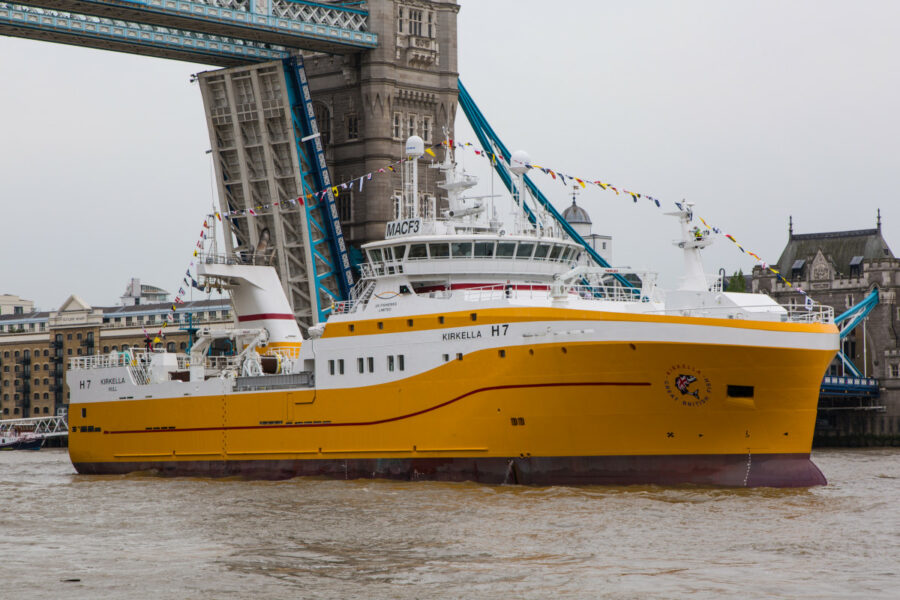Highly automated processing and plate freezing machinery delivering optimum product quality
The advanced and highly automated processing machinery installed on the factory deck of UK Fisheries’ new Hull-based distant-water freezer stern trawler Kirkella H 7 is reported to have performed well since the vessel starting fishing in the second half of last year, reports David Linkie
Given the previously unseen level of sophistication of the equipment and systems – which quickly becomes clearer when explained in detail – the fact that it all worked with the anticipated level of efficiency, from when the first fish was hauled up Kirkella’s wide stern ramp and released into the reception hopper, is a credit to everyone who contributed to the design, manufacture, installation and commissioning of the state-of-the-art factory deck.

Kirkella
Within four hours of whitefish entering the factory deck, it is lowered on pallets to Kirkella’s freezer hold, ready for distribution from Humberside to fish and chip shops throughout the UK, having been filleted, portioned, plate-frozen and packaged to customers’ specific requirements.
Cod and haddock caught within the North East Arctic, at Greenland or in North West Atlantic waters, and marketed under the eye-catching logo of ‘Great British fish’, with a cod bearing a Union Jack, as depicted on Kirkella’s bow, accounts for 8% of the fish used in fish and chip shops across the UK.
Kirkella also breaks new ground by being equipped with an onboard fishmeal plant, which by utilising all the fish heads and offal, means that everything caught by Kirkella is landed and sold commercially.
Before going from Hull to the river Thames last month to be named by HRH The Princess Royal at Greenwich (Fishing News, 2 May), Kirkella had fished five six-week trips to the Arctic grounds. Including the Barents Sea and Bear Island west towards Greenland during the winter months, this provided plenty of opportunities for the vessel to prove her seakeeping qualities, as well as the efficiency of the trawl and factory decks.
By landing around 700t of frozen-at-sea fillets each trip – the equivalent of 2.3m fish suppers – Kirkella and her experienced Hull crew delivered on all fronts, fully justifying UK Fisheries’ decision to order a new factory freezer trawler.
UK Fisheries Ltd was established in 2006 as a joint venture company following the merger of two well-known Hull trawling companies, J Marr Fishing and Boyd Line. The company is run by chief executive officer Jane Sandell, with Sir Barney White-Spunner being chairman of its advisory board.
That Kirkella’s first mate Charlie Waddy has worked with the company and its predecessors for more than 30 years, and that a number of other crew members are well into double figures of service, indicates the important socio-economic role the stern trawler will help to deliver in years to come on Humberside, which for generations of previous fishermen was synonymous with distant-water fishing.
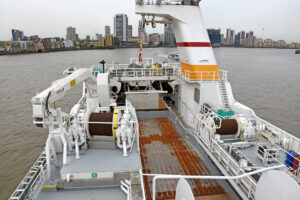
First and second boat decks protect the trawl deck.
Kirkella, which is the seventh Hull trawler to be named after the small village of Kirk Ella, the first being the 157ft steam trawler Kirkella H 319, built at Selby in 1936, was designed by Rolls-Royce Marine AS of Ålesund, Norway.
With main dimensions of LOA 81.21m, length BP 74.40m, beam 16m and depth (main deck) 6.50m, the hull was built to DNV-GL 1A1 stern trawler E0 Ice (1B) TMON classification at the Crist shipyard in Poland and fitted out by Myklebust Verft AS of Norway.
The new Kirkella replaces the previous 86.1m factory freezer trawler of the same name. This vessel was built at the Tersan shipyard at Yalova, Turkey in 2015, and was renamed Lodairo on being sold to the Spanish company Pesquera Ancora last year.
General layout
The layout of Kirkella includes full-length catch-processing and trawl decks, with working conditions on the latter enhanced by a continuous boat deck. A secondary freezer hold (350m³), primarily designated for storing cardboard packaging, is located forward of the factory area at main deck level. The aft engineroom and ancillary machinery compartments, together with the main 1,400m³ freezer hold and 350m³ fishmeal hold, are located under the processing deck.
Completed to the expected modern-day high standards, the vessel’s accommodation areas are arranged from forward of amidships at boat and second boat deck levels. Up to 34 crew members can be accommodated in a combination of 24 single and twin-berth cabins. The statutory and well-equipped ship’s hospital is situated amidships on the port side of the boat deck.
The stainless-steel galley is well-equipped to deliver the culinary requirements for the usual crew complement of 32. Food is served buffet-style in a large messdeck arranged along the starboard side of the boat deck. The messdeck also gives access to a well-appointed central day lounge.
The main crew access to and from the trawl deck is situated to port, through a large changing and PPE storage area. A gym and sauna cabin are also located in this area, together with the ship’s laundry room.
Stern trawling arrangements

Meals for a crew of 32 are prepared in the stainless-steel galley…
The full package of Rauma Brattvaag low-pressure hydraulic deck machinery installed on Kirkella was supplied by Rolls-Royce AS.
Single and twin-rig trawling activities on Kirkella are focused on 8 x 16t sweep-line winches. Positioned forward of four full-length net tracks, the sweep-line winches are used to haul Kirkella’s whitefish hopper nets along the full length of the trawl deck from the top of the stern ramp, which is closed off by a raised vertical door at all times, apart from when hauling and shooting the gear. Small electrical winches, mounted on I-section runners mounted above the trawl tracks on the underside of the boat deck, are used to raise damaged sections of the trawl when the crew are repairing torn gear.
Two 49t split trawl winches, with straight leads to the hanging blocks on the gantry immediately above the stern ramp, are positioned slightly aft of amidships on the boat deck sidewalks above the trawl deck.
Initially spooled with 2,000m of 30mm-diameter Bridon wire, the winches have a capacity for 3,500m of trawl wire.
The middle wire used when twin-rig trawling is handled by a third winch (56t), angled directly towards the middle block and mounted forward and slightly higher than the starboard winch. When fishing, wire lengths are automatically adjusted in line with the skipper’s preferences and information received from the Marport net-management system, using a Rolls-Royce Synchro X7 autotrawl system.
Three 26t Gilson winches, used in conjunction with blocks mounted on the underside of the main trawl gantry to haul the codend up the stern ramp, are arranged at upper boat deck level directly below the wheelhouse.
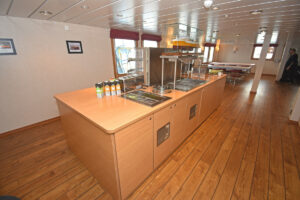
… before being served…
Two 11t outhaul winches and two 18t codend winches complete the main array of net-hauling power.
A large-capacity net drum (46t) is mounted amidships on the boat deck, for use when midwater trawling.
A Triplex 5t @15m knuckle-boom deck crane, mounted on the starboard boat deck, gives flexible lifting facilities across the trawl deck, in addition to being used for unloading frozen products at the end of a trip. A second smaller Triplex crane (3t @ 8m) is mounted on the foredeck to serve the fishmeal hold.
Kirkella’s back-to-back skippers Sigurbjorn Sigurdsson and Sigurbjorn Reimarsson can operate every unit of deck machinery when shooting and hauling fishing gear from the central wheelhouse trawl console, which gives a commanding view of all activities and crew positioning on the trawl deck and in the immediate vicinity of the stern ramp, augmented by a comprehensive CCTV system.
The trawl machinery can also be operated from a control room on the starboard side of the stern ramp. This is particularly useful when the mates and deck crew are working on trawl gear.
Kirkella uses H-Toppur rockhopper trawls. Worked in conjunction with 100m bridles, the bigger net measures 40m on the fishing line, and gives a 7.5m opening when rigged with 100m bridles.
The smaller H-Toppur nets have a fishing line of 31.5m and stand at 5.5m when rigged with 125m bridles.
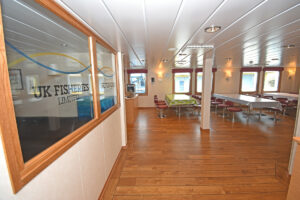
… on the expansive messdeck on the port side of the forecastle deck.
Both sizes of trawl are rigged on 24in-diameter hoppers.
Kirkella uses a set of Thyborøn Type 23 trawl doors (9.5m²/5,300kg) to spread the trawl gear.
A 7,300kg Thyborøn clump is used when fish are more thinly spread on the bottom, and Kirkella easily changes to twin-rig trawling.
Kirkella’s trawls are usually rigged with codends of between 143mm and 155mm – well above the statutory 130mm minimum mesh size permitted for the northeast Atlantic.
An interesting feature of the whitefish trawls is the presence of three ‘trouser legs’ and codends rather than the customary one. This innovation was developed by skipper Sigurbjorn Sigurdsson to further enhance catch quality. Rather than all the fish being held in one bag, catches are spread equally across three. This reduces the pressure on the fish as the gear is towed along the bottom and hauled up the stern ramp.
This arrangement means that six codends are in use when Kirkella is twin-rig trawling.
Engineroom
Kirkella features an integrated Rolls-Royce Marine propulsion package. This is centred on a Bergen Diesel B33-45LB main engine of 3,600kW @ 750rpm, coupled to a matching Kamewa Ulstein gearbox and a 3,800mm-diameter four-bladed CP propeller system.
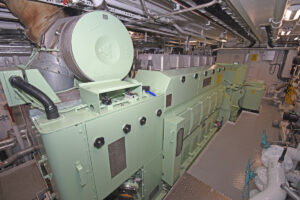
The Rolls-Royce Bergen C25 33L6A auxiliary engine.
The gearbox has a power take-off for a 2,200kW/1,200kW shaft generator, as well as a power take-in that allows the output to the propeller to be boosted by 1,000kW routed from the Rolls-Royce Bergen C25-33L6A auxiliary engine of 1,920kW.
This hybrid el-motor system allows Kirkella to be operated at full power when trawling in deeper water, and to be run on occasion in more economic modes, including a full diesel-electric mode via a 1,000kW electric motor.
A Scania CV AB DI 16-090M emergency/harbour genset of 640kW is also fitted.
Rolls-Royce Marine also supplied the electrically driven 1,650mm-diameter CP bow thruster.
An array of double bottom and vertical tanks carry 500,000 litres of heavy fuel, 120,000 of fuel oil and 145,000 litres of freshwater.
Wheelhouse
Providing full 360° vision, Kirkella’s stylish wheelhouse is fitted out to the highest possible standards. The amount of internal space available reduces the immediate impact of the main free-standing navigation and fishing console, even though this houses an extensive array of some of the newest Furuno type-approved electronic equipment, supplied and installed by Icelandic dealers Brimrun hf.
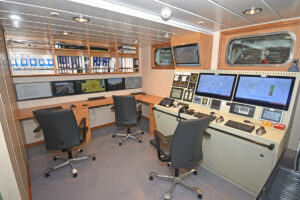 Bottom-sounding and fish detection duties are handled by FSV-30 30kHz, FCV-1900G and DFF3 echosounders. Designed to operate over a wide range of frequencies utilising a broadband transducer, the DFF3-UHD TruEcho CHIRP-enabled network sounder transmits pulses across a wide range of frequencies, allowing Furuno’s superior digital signal-processing (DSP) to display fish and structure targets with unparalleled clarity, accuracy and resolution.
Bottom-sounding and fish detection duties are handled by FSV-30 30kHz, FCV-1900G and DFF3 echosounders. Designed to operate over a wide range of frequencies utilising a broadband transducer, the DFF3-UHD TruEcho CHIRP-enabled network sounder transmits pulses across a wide range of frequencies, allowing Furuno’s superior digital signal-processing (DSP) to display fish and structure targets with unparalleled clarity, accuracy and resolution.
The DFF3-UHD uses a precise sweep pattern across 90 frequencies (50kHz +/-20kHz, 200 kHz +/-25kHz) within a long-duration transmission. The equivalent sound energy transmitted into the water is 10 to 1,000 times greater than a conventional fish-finder, resulting in more energy on target and up to five times greater resolution and depth capability.
In accordance with the new IMO standards required by SOLAS Convention ships, a Furuno FE-800 sounder is also fitted to provide safe navigation by detecting the clearance below the ship when manoeuvring in shallow waters.
A Furuno FSV-85 colour scanning sonar and a CI-68 Doppler Sonar current indicator are also fitted for midwater trawling duties.
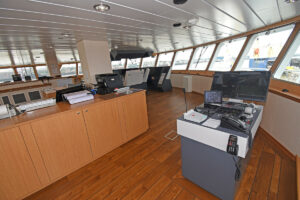
General wheelhouse view.
MaxSea TimeZero and Olex plotting systems also provide 3D seabed mapping presentation, displayed on a bank of 23in Neovo flat-screen monitors, along with the display from the Furuno FMD3100 ECDIS.
Other main navigation aids include two FAR-2117 X-Band and FAR-3230S-SSD radars, Simrad AP70 autopilot, Anschutz GN22 gyro compass, 2 x Furuno GP170 GPS receivers, Furuno SC-110 satellite compass, and Furuno FA150 Class A AIS.
Kirkella’s advanced array of communications equipment includes a Furuno FS 1575 SSB RT, 2 x Furuno FM 8900S and Furuno FM 4721 VHFs, 3 x McMurdo GMDSS handheld VHFs, 2 x Furuno Felcom 18 Sat-Cs, Furuno NX-700B Navtex, Furuno VSAT McMurdo EPIRB G-5-A and Thies Clima weather station.
Kirkella is equipped with a comprehensive Marport net-monitoring system which, together with a Trawl Explorer, door and clump sensors, provides constantly updated graphical and numerical information in relation to the efficiency of the spread of the gear, water temperature, depth, headline height, roll and pitch.
Of all the modern technology onboard Kirkella, among the most important items are the catch sensors, which enable the skipper to closely match fishing levels to processing capacity. In order to deliver top-quality products, the gear is usually hauled back when the catch sensors indicate 8-10t (200 boxes) of fish are in the codends. This self-imposed operational constraint often means that hauling commences within 30 minutes of the trawl starting to fish on the bottom, such is the amount of fish readily available today on traditional distant-water grounds that have been fished for well over 50 years.
Highly automated and high-tech factory deck delivers unprecedented levels of quality and efficiency
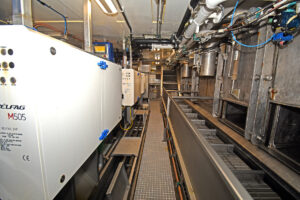
Fish released from the reception hopper are moved by conveyor towards the starboard side of the vessel…
When viewed as a collective unit, and after being explained in detail, the standout feature of Kirkella is most definitely the trawler’s factory deck, where laser-operated machinery and robotic equipment is prominent throughout.
Within less than 40 minutes of prime-quality Arctic cod and haddock flowing out of the reception hopper onto the first receiving conveyor, custom-portioned fillets begin to be placed in the advanced three-stage Optimar plate-freezing system. Within four hours of being caught, the end product is ready to be lowered to the freezer hold.
In this time, fish has been moved progressively forward some 50m along the processing deck, at the same time as traversing the vessel’s beam several times in a continuous process, in which skilled operatives are just as important as the state-of-the-art mechanised equipment.
On untying the codlines, fish are released through remotely operated flush deck hatches at the head of the stern ramp into a suitably-sized reception hopper. From this, they are delivered through one of four hydraulically operated vertical sliding gates onto a conveyor leading across to the starboard side of the catch-processing deck.

… where they are stunned…
After being stunned and selected by species, individual fish are accurately positioned by laser before being de-headed and gutted using three Velfag M 505 machines. The use of laser-controlled clamps ensures that the head is removed at the optimum position, to ensure maximum fillet yield further down the processing line. This immediately highlights the emphasis placed on maximising product return from the natural source that comes aboard Kirkella.
De-headed and gutted fish are subsequently moved forward by conveyor to enter washing tanks, before being delivered to filleting and skinning machines.
Human interaction is essential in the next stage of the process in the trimming area, where the crew carry out quality checks and manually remove any skin that remains. After being checked for any pin bones, whole side fillets are transferred to Flexicut machines, in which computer-controlled water jets are used to produce individual portions in line with customers’ requirements. In addition to portion size – eg, 5oz, 7oz, etc – the computer software can also be programmed to deliver loin, middle or tail selections.

… before being positioned by lasers for heading and gutting.
After being graded and weighed in line with Marel equipment, fillets are plate-frozen down to -30°C using an Optimar freezing system, in which the product is automatically moved across a three-stage process designed to deliver maximum efficiency. Fillets are initially placed into 6.81kg (15lb) inner cartons that are then packed three at a time into master cartons of 20.43kg (45lb) distinctively displaying a photograph of Kirkella.
What essentially is a robot carrier collects the master cartons and allocates them to the selected area in the ‘storage hotel’, from which they are palletised and film-wrapped before being collected and lowered remotely to Kirkella’s freezer hold. The final stage of the production process sees the 60-carton pallets being positioned by fork-lift truck in the freezer hold, where they are kept at an ambient temperature of -28°C for the duration of a trip, until they are offloaded when Kirkella docks at Hull.
In another notable development, Kirkella features an integrated onboard fishmeal plant that ensures zero waste. Instead of going over the side, all fish heads, frames and skin are stored separately and processed by a Hedinn HPP 2000 system. The resulting fishmeal is bagged and stored in a dedicated fishmeal hold for use as animal feed and fertiliser.
Seventh Kirkella for Hull
The new Kirkella is the seventh distant-water trawler to bear a name that has been synonymous with Hull for over 80 years.

Stern view of Kirkella.
The original Kirkella (together with Westella) was the first in a long and prestigious line to bear the suffix ‘ella’. These forerunners were named after the small villages of Kirk Ella and West Ella, situated to the west of Hull and recorded in the Doomsday Book, with ‘kirk’ being Norse for church and ‘ella’ the old Saxon word for pasture.
The first Kirkella H 319 was a 157ft steam-driven side trawler built for J Marr & Son at Selby in 1936, at a cost of £15,950. After being used for anti-submarine patrols during the Second World War as Penant FY 174, the trawler was later bought by Sir Basil Parkes and renamed St Benedict GY 592 before moving to Fleetwood, where the vessel was scrapped in 1960 as Reneva FD 7.
The second Kirkella H 209 was launched at Beverley in 1960. Built at a cost of £160,033, the diesel trawler was sold to Boyd Line Ltd three years later, when it was renamed Arctic Galliard, before becoming Arctic Outlaw in 1973.
The third Kirkella, and the first of four freezer trawlers of the same name, was built at Aberdeen in 1965. This 74.85m vessel fished from Hull for nearly 20 years, and gained the distinction of being the last of the first generation of freezer trawlers to be owned by J Marr & Son, before being converted for use as the standby vessel Seaboard Implacable, which was scrapped in 2005.
Kirkella H 90 arrived at Hull from Holland in 1985 as Enterprise I, after the 58.8m freezer trawler had been built at Scheveningen in 1973 for Ijmuiden owners. This vessel was sold to Cogip Guinea Conakry and renamed Babel I in 1996, and was replaced with the 38.5m Glenrose I. Built at Selby in 1990 primarily as a fresher with some freezing-onboard capacity, this trawler was renamed Kirkella H 2, before being replaced by Marbella in 1996.
The sixth Kirkella, an 86.1m factory freezer trawler, passed Spurn Point for the first time in March 2015 on its way up the Humber to dock at Hull, following a delivery voyage from Yalova, Turkey, where the vessel was built at the Tersan shipyard. When the new Kirkella was nearing completion last year, its predecessor was sold to the Spanish company Pesquera Ancora and renamed Lodairo.
Maintaining current fishing opportunities of paramount importance

Four rockhopper trawls are available to use in single or twin-rig configuration from the full-length trawl deck.
Kirkella fishes in the northern external waters of the EU. This means that all of its fishing opportunities come from agreements between the European Union and third countries, such as Norway and Greenland.
UK fishing vessels have been operating in the northern external waters for centuries, with Kirkella as one of the few remaining UK vessels working in these waters.
Once the UK has left the EU, and is an independent coastal state, the UK will negotiate fisheries agreements with these countries in its own right. This means that the UK negotiating team will be able to decide what is important to the UK and deliver on these objectives, rather than having to agree on priorities with other member states of the EU.
It means that the overall benefit to the UK of any external agreement can be assessed, with the supply chain benefit and the added value to the UK taken into account.
Kirkella supplies around 8% of the fish suppers in the UK, according to figures from the National Federation of Fish Fryers.
This means that the fishing opportunities that come from the northern external waters agreements are important to the UK fish and chip shop trade, and the UK administration must ensure that the opportunities that are available within the current framework are guaranteed when the UK is a truly independent coastal state.

